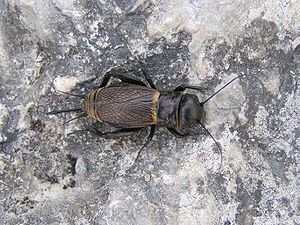Real crickets
| Real crickets | ||||||||||
|---|---|---|---|---|---|---|---|---|---|---|

Female of the field cricket ( Gryllus campestris ) |
||||||||||
| Systematics | ||||||||||
|
||||||||||
| Scientific name | ||||||||||
| Gryllidae | ||||||||||
| Laicharting , 1781 |
The real crickets (Gryllidae) are a family of insects and belong to the order of long-feeler terrors (Ensifera), which also includes the grasshopper (Tettigoniidae).
features
Like the grasshoppers, crickets have elongated hind legs, adapted for jumping, and long cord-like antennae .
In contrast to the grasshoppers, which place the front part of their wings next to each other like a roof when in rest position, the cover wings of the crickets lie flat on top of each other, almost always the right over the left front wing.
All crickets love heat and are hemimetabolic . This means that their larvae and nymphs look very similar to the adults and that they do not have a pupal stage.
communication
The sound production in the male crickets is called stridulation . Here, a serrated shrill loader on the underside of the right fore wing is quickly moved back and forth over the trailing edge of the other fore wing. The stridulation serves to demarcate the territory and attract the females. Based on the number of sounds emitted by certain types of crickets within a certain time interval, the current air temperature can be inferred from Dolbear's law .
Reproduction
As with many other animal species, the female crickets strive for the largest possible number of sexual partners. A research group led by Tracie Ivy from Illinois State University (USA) has found that females of the southern house cricket ( Gryllodes sigillatus , also called short-winged cricket) mark their numerous sexual partners with their scent, thus avoiding re-pairing with the same male and increasing the genetic Diversity of your offspring and their chances of survival. Since the female's own smell is always present for direct comparison, this method does not require any learning ability.
species
In several subfamilies there are over a hundred different types of real crickets worldwide, here is a selection:
- Brachytrupinae
-
Gryllinae
- Crickets - Acheta domesticus
- Short-winged cricket or southern house cricket - Gryllodes supplicans
- Steppe cricket - Gryllus assimilis
- Mediterranean field cricket - Gryllus bimaculatus
- Field cricket - Gryllus campestris
- Japanese Sing Grille (in Japan Suzumushi called) - Meloimorpha japonica
- Eastern Cricket - Modicogryllus frontalis
- Forest cricket - Nemobius sylvestris
- Swamp cricket - Pteronemobius heydeni
- Mormon cricket - Anabrus simplex
- Gryllomiminae
- Gryllomorphinae
- Itarinae
- Land revinae
-
Tree cricket - Oecanthinae
- Wine Chicken - Oecanthus pellucens
- Sclerogryllinae
The mole crickets (Gryllotalpidae) do not belong to the real crickets, but form their own family within the same order.
Importance of crickets in cultural entomology
In Japan , "singing" crickets are popular pets . The males of Meloimorpha japonica , in Japanese Suzu-mushi, are offered in small boxes in Japanese cities and there are singing competitions, with the singing crickets with the most beautiful singing being chosen.
In China , people have been keeping "singing" crickets in small cages for centuries, made from pumpkins, bamboo, wood and metal, and in recent years also from Bakelite and other plastics. Clay containers are the dwellings for crickets that are used in competitions.
Crickets are also used as feed insects (see also: Grigfarm Rotter ).
Competitions
In a competition, two males are let loose on each other in a circled ring. Since the males are aggressive, they almost always attack each other in the same way when they come into contact with one another. With a prepared stalk, on the front of which there are hairs, you steer the crickets in the right direction. Betting stakes in China at private events can rise to considerable sums. Otherwise you can also make small bets at animal markets in the cities or just watch.
literature
- Max Beier, Lucien Chopard: Orthopterorum Catalogus. Junk, The Hague 1962-71.
- Max Beier, Franz Heikertinger: Grilling and mole crickets. in: The new Brehm library. (119), Westarp, Hohenwarsleben 2003. (Reprint from 1954) ISBN 3-89432-585-2 .
- Huber, Franz: Sound utterances and sound recognition in insects (crickets). Westdeutscher Verlag, Opladen 1977. ISBN 3-531-08265-5 .
- Otte, Daniel: Orthoptera species file. Volume 1, Philadelphia 1994. ISBN 0-9640101-1-9 , ISBN 0-9640101-2-7 .
- Otte, Daniel & Richard D. Alexander: The Australian crickets. Philadelphia 1983.
- Ragge, David R. & WJ Reynolds: The songs of the grasshoppers and crickets of Western Europe. Harley, Colchester 1998. ISBN 0-946589-49-6 .
Individual evidence
- ↑ Measuring temperature using crickets Globe Scientists' Blog, posted 05/10/2007
- ↑ Akito Y. Kawahara: Thirty-foot telescopic nets, bug-collecting video games, and pet beetles: Entomology in modern Japan. American Entomologist 53 (3): 160-172.
- ↑ Sarah Wagner: Chinese cricket fights: ring free for sex-hungry six-legged friends. In: Focus Online . November 8, 2011, accessed October 14, 2018 .
